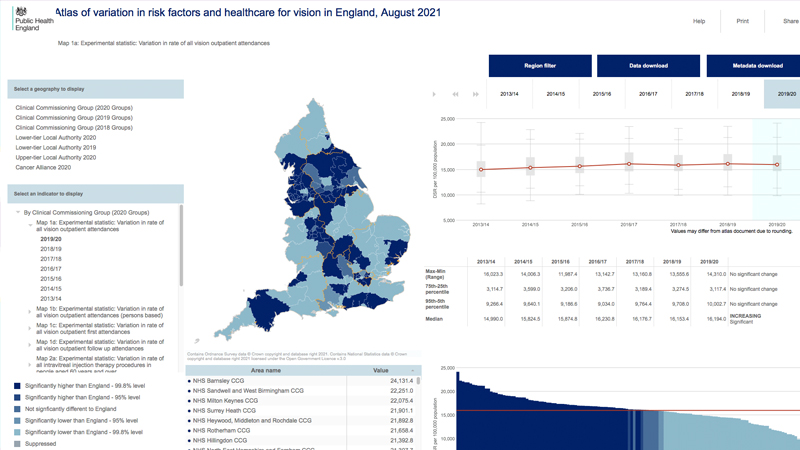PHE Publishes Their Vision Atlas
25 August 2021

Public Health England has published their first Vision Atlas. The Atlas brings together 32 indicators across the whole vision pathway. A tool to help monitor population eye health.
In 2019/20, there were 9 million outpatient attendances for eye health (equating to approx 3.4 million individual patients). The atlas helps to understand inequalities in eye health across the country.
New analyses of hospital eye services including outpatient appointments, intravitreal injections, cataract and retinal detachment surgery are presented, revealing local and regional variations that to date have remained unrecognised. In doing so, the Atlas has:
- Highlighted and quantified variations across a range of eye health indicators that will be hard to overlook, and deserve closer local review and scrutiny to understand their underlying causes and outliers
- Called for making better use of existing data sources and improving their quality
- Highlighted the lack of routinely available, granular data from services provided in primary eye care and the need to ensure that is addressed.
LOCSU’s interim clinical director Zoe Richmond said:
“I welcome this new atlas of variation, it’s a much-needed resource to help monitor population eye health and will become a vital tool to support service planning. Thanks must go to Parul Desai and colleagues for leading this fabulous and timely piece of work.
“The vision atlas begins to bring together key information so that systems can better understand inequalities in eye health. The atlas provides good information about hospital eye services, as well as risk factors for eye disease, in time I hope it’s scope can be expanded to include more information on primary eye care. In the meantime, LOCSU’s Optical Lead team and LOC leads are well placed to support local systems to scrutinise the data and develop plans to help address unwarranted variation.
“Publication of the new vision atlas is very timely; it provides data immediately before and during the pandemic and so offers helpful information to better understand the impact of the pandemic but also provide a vital resource as systems design services to support recovery.”
Chair of the CCEHC, Parul Desai said:
“The Atlas is timely, presenting trends in the years immediately prior to, and provisional data during the coronavirus (COVID-19) pandemic, as a resource to support planning and monitoring the impact of actions taken by clinicians, CCGs, ICSs, providers and policymakers locally, and by the National Eye Care Recovery and Transformation Programme.
“It should not be seen as a one-off, but as a starting point for local discussion and action. It will be a significant tool to help monitor population eye health and its contributory factors. Practical options for action are proposed that could make meaningful differences to patients, and the quality, accessibility and consistency of care provided by eye health services – now and in the longer term.”
Access to the data underpinning the indicators is available through the Interactive Atlas, an online tool to support review and interpretation of local variations in health service indicators, and prevalence of risk factors for poor vision health.

